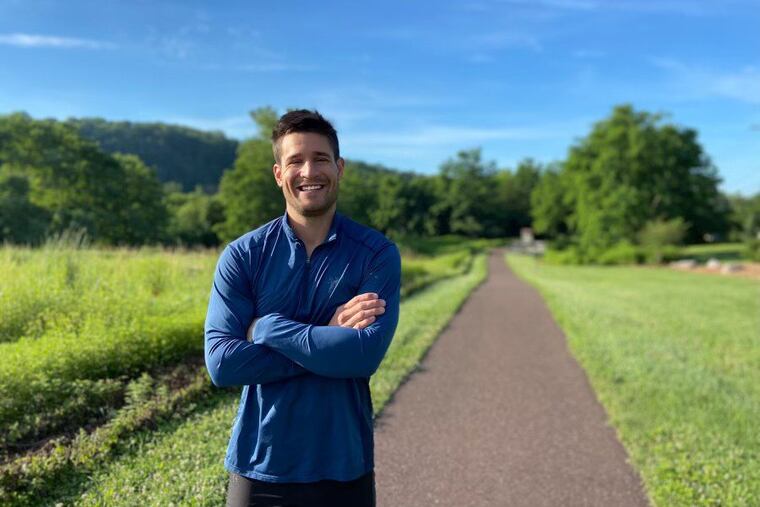Medical Mystery: Sudden back pain had ultra-marathoner struggling just to walk
He felt like he was “losing his mind,” he recalled, as he went from running every day to struggling just to walk to the bathroom, as his legs had become tight, heavier, and more painful.

An ultramarathoner, Jonathan Rizzo runs an hour to two hours every day. On a November 2020 run, though, he felt a pop in his back and an immediate pain that stopped him in his tracks. Rizzo, who lives in Phoenixville, called his wife because he was worried she would have to come to pick him up, but he was able to walk back home.
A quick internet search of his symptoms led him to believe he was suffering from a herniated disc, so he made an appointment to see a sports medicine physician. The doctor agreed he likely had a herniated disc and suggested physical therapy.
The sessions were miserable for Rizzo and his pain did not lessen, so he sought a second opinion.
Another physician ordered an X-ray of his spine, which only revealed that his bone structure looked fine. A follow-up appointment was made for an MRI scan.
Over the next two months, Rizzo continued to feel pain, which now radiated from his lower back down his legs. He stopped running, and even short walks or shoveling snow exhausted him.
He felt as if he were losing his mind, he recalled, as he went from running every day to struggling just to walk to the bathroom, as his legs felt tight, heavier, and more painful.
» READ MORE: Medical mystery: Chronic shoulder pain masked a more serious problem
Solution
Rizzo was on his way home from an MRI scan when he got a call from the radiologist, instructing him to go to the ER immediately. The scans showed a massive blood clot in his inferior vena cava and iliac veins, the largest veins that drain blood from the lower body to the heart.
At the ER, a CT scan confirmed that the inferior vena cava and iliac veins were blocked, as seen on the MRI. He underwent a procedure to try to unblock his veins, but the material was too hard to go through. The surgeon took a piece of the blockage for a biopsy.
His physicians were perplexed at how he was able to function and were concerned that the material might have been a rare tumor of the blood vessels. He was kept in the ER for observation and started on blood thinners.
He underwent several more diagnostic tests for clotting disorders, which were all negative. The biopsy didn’t reveal a diagnosis. There was no family history of blood clotting or any other clues to differentiate a cancer in his blood vessels from a massive blood clot blocking his veins.
Although his leg swelling resolved with medication, months later he was still unable to return to normal activity, with just a 30-minute walk sending him to his bed for several days with severe pain. He was also experiencing dizziness, nausea, tingling in his legs, and pressure in his tailbone that would return anytime he did any physical activity.
» READ MORE: Medical mystery: A dentist’s severe pain signaled a nearly invisible disorder
He was referred to me in hopes of determining the source of the blockage. I decided to pursue a minimally invasive procedure to remove portions of the material blocking his veins and reconstruct the veins to allow for improved blood flow. Essentially, his venous system was bypassing blood through small, narrow channels to compensate for the blockage, which was not getting blood back to his heart efficiently, leading to his symptoms.
In April, he underwent an eight-hour procedure, which involved accessing veins in both thighs and the jugular vein in his neck. After successfully crossing the blocked veins, which required several hours of connecting the small pathways, a device was inserted to remove as much of the material from his inferior vena cava as possible. This material was reviewed during the procedure and did not show any evidence of cancer. We rebuilt his normal vein structure with stents, leading to fast blood flow through this new system, rather than filling the small channels his body had been using previously.
Rizzo recovered quickly after surgery and was back to running well before anyone could have expected. He said he feels “brand new” since his body isn’t working harder during exercise to compensate for poor blood flow.
The cause of his blockage is likely related to scarring in the veins from a prior blood clot, but it remains a mystery when it began. It may have started when he was a premature infant, requiring catheters placed in his veins, which may have caused scarring that put him at risk for this occurring later in life.
He will continue to come in for routine appointments and tests to make sure he doesn’t develop another blood clot, but for now, we are excited for him to return to running several miles per day without difficulty or symptoms.
Ronald Winokur is an interventional radiologist, associate professor of radiology, and the director of venous interventions at Thomas Jefferson University Hospital.